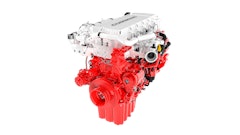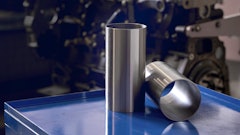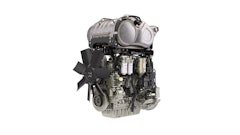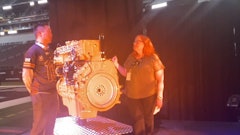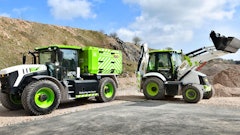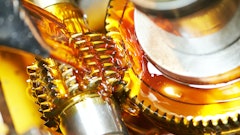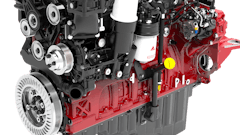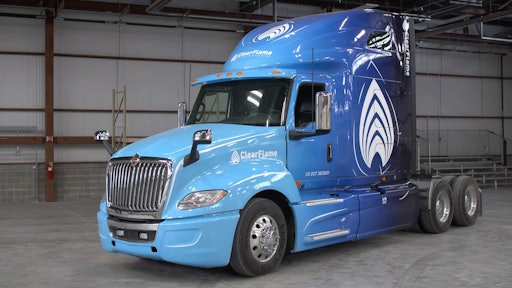
Solutions are needed that can mitigate the 4.8 gigatons of annual carbon dioxide (CO2) emissions generated globally from heavy-duty sectors that use diesel fuel. These include on-road transportation and off-highway equipment. While electrification helps curb tailpipe emissions of light-duty, medium-duty and short-range transportation, large-scale deployment for heavy-duty and off-highway sectors is still decades away. These industries need solutions for decarbonization today to help meet global climate goals.
The Challenge
Diesel engines are critical to world economies. However, they contribute to local air pollution, and the burning of fossil fuels is currently the largest contributor to greenhouse gas emissions from human activities. Projections suggest that even with a growing number of alternatives, only 25% of new heavy-duty trucks in 2035 will be rated for zero tailpipe emissions. This leaves the remaining 75% to rely on fossil fuel unless other alternatives are developed. Additionally, the number of heavy-duty vehicles on the market continues to increase, with nearly 359,000 Class-8 vehicles expected in production in 2022.
The size of the diesel emissions problem and the wide range of applications in which these engines are used have created a search for decarbonization solutions across the heavy-duty industry. One question often asked is: How fast can we get to zero emissions? Framing the question in this way creates a single, acceptable outcome—only the solutions with perfect, zero emissions are the ones worth implementing.
However, if all the diesel emissions were cut in half today, the industry would have twice as long to find the quickest path to zero emissions. Perhaps a better question is: How quickly can we reduce emissions? This way, the industry can prioritize progress toward that perfect future without discounting provisional solutions that can help get the industry there sooner. In stronger words, focusing exclusively on zero tailpipe emission solutions impedes the progress the industry can make and needs to be making by deploying midterm solutions that offer significant emissions reductions today.
Key Considerations
Four key factors should be considered when assessing emissions reduction for on- and off-highway applications:
- Life-cycle emissions as the primary metric—Reducing life-cycle greenhouse gas (GHG) emissions is essential for lowering atmospheric GHG levels, the driver of climate change. Different actions generate the addition or removal of GHGs into the atmosphere. However, like a bank account, the net effect of those activities impacts the balance. To illustrate, while a vehicle powered by net-carbon-negative fuel might not deliver zero CO2 emissions at the tailpipe, the aggregate effect of that fuel reduces GHG levels in the atmosphere. Similarly, battery-powered equipment charged by a carbon-intensive source contributes to climate change, despite emitting zero tailpipe emissions. This life-cycle framework has been used for decades by leading institutions studying climate. It is essential when assessing the true emissions reductions of alternative technologies.
- Time sensitivity of emissions reduction—The financial analogy of atmospheric carbon also applies to the time-sensitivity of reducing GHGs. Like a loan deferral, getting a later start on emissions reduction requires moving more quickly to arrive at the same climate impact by 2100 (see Figure 1). Global emissions have already arrived at a point where the rate of reduction required is basically impossible. If the industry starts in 2022, emissions need to reduce by 14% in 2024. That is the same size as the total emissions from transportation (road, rail, air and marine). That rate only increases the longer action is deferred.
 Figure 1. Emission reduction trajectories associated with limiting warming below 1.5 degrees C based on the starting year. Solid black lines show historical emissions while dotted lines show emissions constant at 2018 levels.Carbon Brief
Figure 1. Emission reduction trajectories associated with limiting warming below 1.5 degrees C based on the starting year. Solid black lines show historical emissions while dotted lines show emissions constant at 2018 levels.Carbon Brief - Air quality considerations—Air quality continues to impact human health, particularly in heavily congested, urban areas. Criteria emissions such as soot and NOx have long been linked to higher rates of asthma, heart disease, and other respiratory and cardiovascular illnesses. For the children living in areas with significant diesel pollution, every step forward in emissions reduction matters. Waiting 10 to 15 years for solutions is unacceptable.
- Total cost of ownership—The total cost of ownership (TCO) is a key driver for equipment owners for which cost and performance are critical to their business. The cost of equipment, operation and maintenance all factor into a TCO calculation. While lowering emissions, it is essential to provide solutions that have compelling TCO to allow end users to remain productive and profitable.
Benefits of Decarbonized Liquid Fuels
With life-cycle emissions, time sensitivity, and air quality framing the emissions challenge, alternative solutions are both necessary and timely. Decarbonized liquid fuels can play a role, providing a rapid pathway to reducing engine-out emissions today. These include a range of biofuels and synthetic fuels, which can be scaled more quickly than electrification for heavy-duty applications. They will enable faster emissions reduction.
Using 100 percent renewable, plant-based fuels like ethanol is the basis for some engine modification technology. One solution enables these fuels to be easily integrated into existing diesel engine platforms, replacing dirty diesel fuel and offering a quickly scalable, lower emission, lower-cost solution.
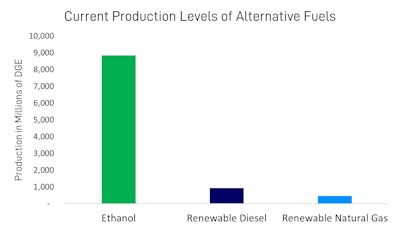 Figure 2. Current production levels of alternative fuels on a DGE basisClearFlame Engine Technologies
Figure 2. Current production levels of alternative fuels on a DGE basisClearFlame Engine Technologies
- Scalability—Using ethanol takes advantage of an existing fuel distribution infrastructure. More than 15 billion gallons are produced in the U.S. each year, making it the most abundant alternative fuel source (see Figure 2).
- Lower emissions—Fuels like ethanol can significantly move the needle regarding emissions reduction. Research from Harvard and Argonne National Laboratory show that the life-cycle carbon intensity of U.S. ethanol is approximately 45% lower than diesel or gasoline. It is also lower than that of electricity using the national grid average.
- Clean burning capabilities—Small-molecule liquid fuels, such as ethanol or methanol, burn so cleanly, even in a diesel engine cycle, that they produce soot-free emissions, providing immediate air quality benefits. Additional benefits can be derived by eliminating the need for a diesel particulate filter or at least ensuring it never needs to regenerate. Engine data collected by the solution provider’s engineers demonstrated engine-out soot emissions at lower levels than the Environmental Protection Agency’s regulation for on-road tailpipe levels (see Figure 3).
 Figure 3. Engine-out soot measurements collected on a diesel engine operating on E98 ethanol fuel.ClearFlame Engine Technologies
Figure 3. Engine-out soot measurements collected on a diesel engine operating on E98 ethanol fuel.ClearFlame Engine Technologies - Cost—A well-established, scaled and distributed, decarbonized liquid fuel like ethanol can lower the TCO for end users when compared to their existing diesel equipment. On a diesel gallon equivalent basis (DGE), ethanol was lower cost than diesel fuel in 2021. In the current, 2022 environment, it is $2 per DGE lower in cost. This fuel price advantage significantly impacts the TCO of equipment if they are powered by low-cost fuels like ethanol instead of more expensive diesel fuel. While many solutions ask customers to pay more to “go green,” low-cost liquid fuels can simultaneously lower costs and emissions.
For agricultural applications, the potential exists to create a virtuous cycle by operating the equipment on the same fuel that many farms already help to produce. The life-cycle carbon intensity of ethanol accounts for the emissions of the equipment used to plant, harvest and transport the crops. By powering equipment with low-carbon ethanol, the life-cycle carbon intensity of fuel produced will be lower.
Figure 4 compares fuel and energy types used in transportation and equipment, demonstrating their carbon intensity and how it has decreased over time. Alternative fuels have and continue to improve (faster than the grid), contributing to the low life-cycle GHG of any equipment or vehicles that use those fuels.  Figure 4. A comparison among transportation energy sources: Historical and projected average carbon intensity of U.S. fuel energy efficiency ratioLee et al., Argonne National Laboratory
Figure 4. A comparison among transportation energy sources: Historical and projected average carbon intensity of U.S. fuel energy efficiency ratioLee et al., Argonne National Laboratory
The Future
No silver-bullet solution exists today for helping the industry meet its emissions and climate targets, but a policy and market environment that incentivizes outcomes rather than one solution over another ultimately benefits on- and off-highway equipment owners and users. By embracing a range of technologies, the industry can make the goal of rapidly reducing diesel emissions achievable, moving closer to a clean and equitable future.
Resources
- “Bloomberg NEF’s global EV outlook 2021: Commercial vehicles,” Bloomberg. https://www.bloomberg.com/professional/blog/bloombergnefs-global-ev-outlook-2021-commercial-vehicles/
- “All Signs Point up: Analysts See Robust and Growing Demand for Future Diesel Products in on and Off-Road Applications in 2022,” Diesel Technology Forum. https://www.dieselforum.org/policyinsider/all-signs-point-up-analysts-see-robust-and-growing-demand-for-future-diesel-products-in-on-and-off-road-applications-in-2022
- Carbon intensity of corn ethanol in the United States: state of the science, IOPscience. https://iopscience.iop.org/article/10.1088/1748-9326/abde08
- Lee et al. Argonne National Laboratory, DOI: 10.1002/bbb.2225; Biofuels. Bioprod. Bioref. (2021).
- Hausfather, Zeke, Carbon Brief. UNEP: 1.5C climate target ‘slipping out of reach.’ https://www.carbonbrief.org/unep-1-5c-climate-target-slipping-out-of-reach/
Dr. Julie Blumreiter is the chief technology officer and cofounder of ClearFlame Engine Technologies.











